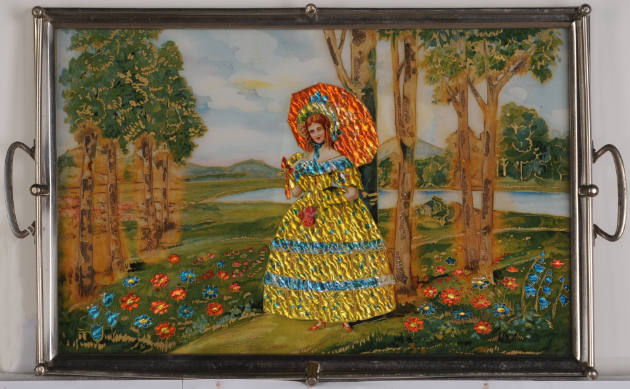
Imagine taking tiny strands of tin, crumpling them up, straightening them out, and piecing them together on the back of painted glass. If you were a woman learning domestic arts in the early 19th century, tinsel painting is a domestic art form you might have learned.
In short:
Tinsel painting technique involved taking crumpled or straight metallic strands and using them on the reverse side of translucent painted glass. The origins of this lost art come from similar art forms developed in Renaissance Italy, 18th-century China, and France, as well as 19th-century Austria, England, and Germany. Tinsel paintings were done by women to add beauty and individuality to their home’s décor.
Want to know more? Take a deep dive:
As a female in the early 19th century, one was expected to learn gentle art skills that would be used to decorate their homes. Tinsel painting was one of those art skills, and it required a lot of practice. Tinsel painting was done by taking thin strands of tin, crumpling them up, and placing them in intricate patterns on the backside of translucent painted glass. Artists would use translucent paints or thinned oil paints and apply the colors with pens or brushes. The idea was to create a softly colored opaque picture. Most of the themes for these pictures were of nature, birds, flowers, or patriotism. What was interesting is where early artists found bits of tin to use. They would take the tin wrappers from candy or packaging from the pharmacy and slice them into different sized strands to use in their paintings. Once tin foil was developed and used more commonly at home, it was easier for artists to have tin to use.
But tinsel painting was more than just sticking tinsel on the backside of glass. The reality is tinsel painting required a great deal of thought and planning since it was essentially done in reverse. The artist would have an idea of the painting they wanted to do. Then, they worked in reverse, as tinsel painting is done in layers. The glass would need to be flipped over since the painting was done on the back. Then, the artist would need to know what layers of paint they needed and when they would place the layers of tin. In essence, the whole process worked backward, and the artist needed to be mindful of that fact when planning their picture. For example, if one were creating a floral picture, the stems and veins would be painted first and the rest of the picture would be worked backward until the background color was painted last. Once the paint had dried, tinsel was added wherever the artist wanted to highlight a feature of the painting. As a final step, newspaper would be used to cover the tinsel and painting, and then a cardboard cover was added to finish off and seal the project.
As a domestic art, tinsel painting was greatly admired. It required a tremendous amount of concentration from the female artist, and finished pictures were usually smaller and added to home décor. It allowed women to express themselves artistically when decorating their homes. What's more, once gas lights were more common in homes, tinsel paintings added a gentle shimmer of color to walls. Tinsel painting encouraged women’s creativity; they could be creative with elements such as how thick or thin lines were, what colors they chose to use, and how many layers there were to their design. But most women started with a basic design idea found in manuals and women’s magazines.
One of the most notable tinsel painting artists was Alice Knight. Originally born Alice Archer in England, she immigrated to America in 1889 and eventually

moved to New Hampshire, where she met and married her husband, Charles Knight. Ms. Knight is most known for creating complex reverse paintings on glass, such as her Urn of Flowers with Scene from Ballet Swan Lake versions. She had an incredible talent for mixing colors to use in her tinsel paintings.
Today, this form of folk art is enjoying a renewed interest from collectors. These tinsel paintings are unique, and collectors are realizing their value both as collectibles and as home decorations.

In 2013 The American Folk Art Museum in New York presented the exhibition “Foiled: Tinsel Painting in America” and it was the most comprehensive museum exhibition to focus on this under-recognized decorative art. The American Folk Art Museum is now the largest public repository of this fascinating artform.














Comments